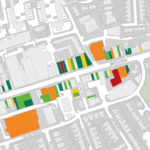A number of things may come to mind when we think of what constitutes good public realm. Beautiful and purpose-built landscaping. Intriguing features that give identity to the area. Green and accessible to all. Vibrant and well-maintained, with spaces to stop, rest and play. But what if I said to you: managed freight and servicing activity?
It may not be one of the first things we associate with good public spaces, and it’s certainly not the most glamorous, but it is arguably one of the most critical.
Deliveries and servicing are integral to almost all aspects of human life; a fact we have come to appreciate even more in the midst of the current pandemic. Whilst major new developments are often required to provide off-street facilities that cater for it, lots of delivery and servicing activity in towns and cities takes place on-street. And this is often necessary, particularly in areas where there is limited potential to carry it out elsewhere.
Striking a balance on Carnaby Street
Take Carnaby Street in London for example. This area is pedestrianised for most of the day, but permits access for deliveries and servicing between 7am-11am. And the reason for this is simple – it can’t take place anywhere else. The surrounding streets are pedestrianised and, even if they weren’t, the premium value of floorspace and conservation-area status limits the opportunity to remove this activity from the street. The restricted-access approach for vehicles therefore strikes a balance between the servicing needs of buildings and the provision of high-quality pedestrian space.
But there’s no getting away from it. Public spaces are better when vehicular activity, including deliveries and servicing, is limited through management. Why?
• Reduced kerbside vehicle activity
• Safer environments for pedestrians and cyclists
• Lower air and noise pollution
• Increased opportunities to re-purpose loading areas to more ‘public realm-y’ uses (eg wider footways, parklets, planting, outdoor seating for businesses etc)
Ultimately, the above leads to better environments to work, visit and do business. In fact the DfT’s ‘Gear Change: A Bold Vision for Cycling and Walking’ document highlighted that well planned streetscape improvements (of which managed delivery and servicing activity can form a part) can lead to a 40% increase in retail footfall.
Managing the impact of deliveries and servicing
So, from a business / organisational perspective*, what are some of the ways that we can manage the level and associated impact of deliveries and servicing in our cities?
• Consolidation hubs – by diverting our various daily deliveries to outer city/town consolidation centres, each of the goods bound for a building can be loaded onto fewer, more efficiently-loaded vehicles
• Cleaner last mile logistics – related to the above, many companies operating consolidation hubs can carry out the final leg of the delivery journey (from the hub to the customer) via electric vehicles, cargo freight and other low-emission modes
• Collaborative procurement – multiple organisations can come together to source commonly purchased goods or services from a reduced number of suppliers. Often mediated by Business Improvement Districts (BIDs) or similar groups, this can reduce servicing vehicle numbers and overall vehicle mileage
• Supplier rationalisation – could fall under collaborative procurement, but can also be carried out by a single organisation reducing the number of contracts/suppliers, and therefore deliveries, for the purchase of similar goods
• Behavioural change – discouraging personal staff deliveries to the workplace, and instead promoting use of collection points (eg Click and Collect, Amazon Lockers) or home deliveries, can reduce congestion and kerbside activity in towns and cities
* Residential deliveries and servicing require consideration of alternate factors and solutions to the ones given above
Whilst each organisation will have unique servicing requirements to be considered, the above approaches can help to achieve improved management of this activity, thereby contributing to better public spaces for all.
And at a time in our cities where these public spaces are quieter than usual, there is a unique opportunity to consider ways to improve them ready for our return. The relationship between deliveries, servicing and public realm, a subtle yet important one, should not be forgotten in this regard.







